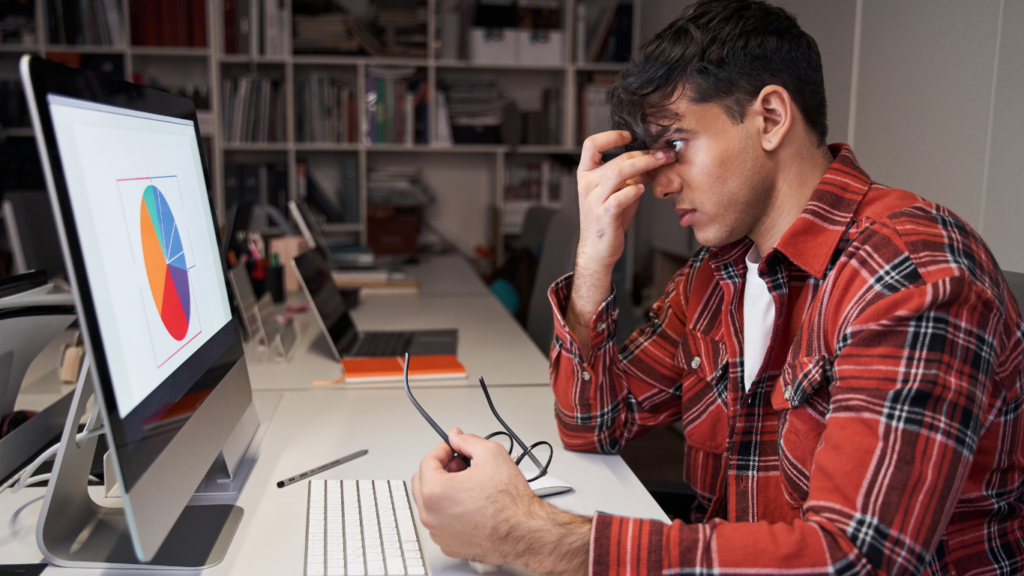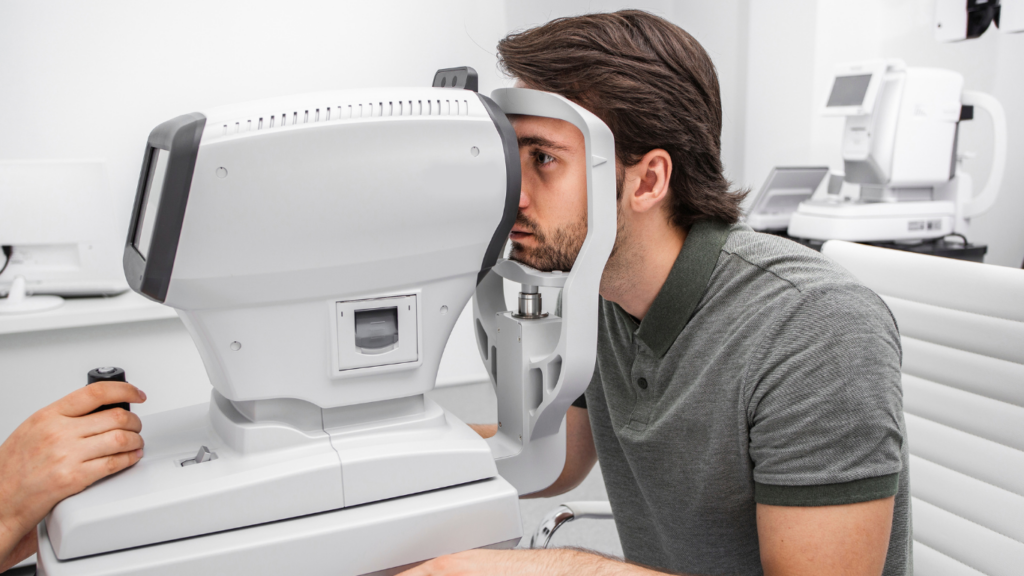In today’s fast-paced world, screens are an integral part of our daily lives. From smartphones and tablets to computers and televisions, we’re surrounded by digital devices at work and home. While technology has undoubtedly transformed our world in many positive ways, it also comes with its downsides, particularly when it comes to our eye health. One of the most common concerns arising from prolonged screen time is digital eye strain, also known as computer vision syndrome (CVS).
As we spend more time in front of digital screens, the risk of eye discomfort, fatigue, and long-term vision problems increases. Fortunately, with the right knowledge and precautions, you can protect your eyes and reduce the strain caused by digital devices. Let’s explore what digital eye strain is, how it affects our vision, and most importantly, how you can protect your eyes in the digital age.

What is Digital Eye Strain?
Digital eye strain refers to the discomfort or fatigue that occurs after extended periods of using digital screens. This condition is becoming increasingly prevalent due to the rise in screen time for work, entertainment, and socializing. While digital eye strain doesn’t usually lead to permanent vision problems, the symptoms can be annoying and disruptive. The effects often worsen with prolonged exposure and inadequate preventive measures.
Common symptoms of digital eye strain include:
- Dry, tired, or itchy eyes
- Blurry vision or difficulty focusing
- Headaches or migraines
- Neck or shoulder pain
- Increased sensitivity to light
- Difficulty in reading small text on screens
These symptoms are caused by a combination of factors. When looking at screens, we tend to blink less often, which can lead to dryness and irritation in the eyes. The blue light emitted by screens also contributes to eye fatigue, and the prolonged close-up viewing of digital screens can strain the muscles of the eyes, contributing to discomfort.
The Link Between Digital Eye Strain and Myopia
Digital eye strain isn’t the only eye problem linked to excessive screen time. A growing concern among optometrists is the impact of screen time on the development of myopia, or nearsightedness. Myopia occurs when the eye grows too long from front to back, causing distant objects to appear blurry. Although genetics play a role in the development of myopia, excessive screen time, especially at a young age, has been linked to an increase in the condition.
Recent studies suggest that children who spend a lot of time on digital devices or engage in near work (such as reading or playing video games) are more likely to develop myopia. While myopia typically stabilizes in adulthood, its progression can cause other vision issues and increase the risk of serious eye conditions like retinal detachment, glaucoma, or cataracts later in life.
The rise of myopia in younger populations is concerning because myopia can affect one’s quality of life and ability to perform everyday tasks. It’s important to monitor and manage screen time to prevent or slow the progression of myopia in children and adults.
Tips for Preventing Digital Eye Strain
The good news is that digital eye strain can be minimized with a few simple adjustments to your routine. Here are some practical tips that can help reduce the strain on your eyes while using digital devices:
1. Follow the 20-20-20 Rule
One of the easiest ways to reduce eye strain is by following the 20-20-20 rule. Every 20 minutes, take a 20-second break and look at something 20 feet away. This allows your eye muscles to relax and refocus, helping reduce fatigue. It’s an easy habit to adopt, and you can set a timer or use apps designed to remind you to take these breaks regularly.
2. Adjust Your Screen Settings
Your screen’s brightness and contrast should be set to a level that’s comfortable for your eyes. If the screen is too bright compared to the surrounding light, it can cause strain. Conversely, a very dim screen against bright surroundings can also lead to discomfort. Consider using night mode or blue light filters, especially when using screens in the evening.
Additionally, increasing text size and adjusting the font style can reduce the need for excessive squinting. This is especially helpful if you’re working on documents, reading, or browsing the internet.

3. Position Your Screen Properly
The position of your screen plays a significant role in reducing strain. Ideally, the screen should be placed about an arm’s length away from your eyes, with the top of the screen level with or slightly below your eye level. This allows you to look at the screen without tilting your head or straining your neck and eyes.
4. Use Artificial Tears or Lubricating Eye Drops
When working on a screen for extended periods, we tend to blink less frequently, which leads to dry eyes. To combat this, use artificial tears or lubricating eye drops to keep your eyes moist and relieve irritation. Be sure to consult with your eye care professional to choose the right drops for your needs.
5. Limit Blue Light Exposure
Blue light, which is emitted by digital screens, can disrupt your sleep cycle and contribute to eye strain. There are special glasses available that block blue light, or you can use built-in settings on your devices to reduce blue light exposure. Many smartphones, tablets, and computers have a blue light reduction feature that can be activated in the evening.
6. Blink More Frequently
Blinking is a natural way to lubricate your eyes and reduce dryness. However, when using digital devices, we often blink less frequently, which can lead to discomfort. Make a conscious effort to blink more often when using screens, especially if you notice that your eyes are feeling dry or tired.
7. Get Regular Eye Exams
One of the most important things you can do to protect your eye health in the digital age is to schedule regular eye exams. An optometrist can detect early signs of digital eye strain, myopia, and other vision problems that may arise from prolonged screen use. Regular eye exams will ensure that any vision issues are addressed early on, helping you maintain good eye health.
If you’re looking for a vision doctor near you, make sure to find one who specializes in eye care for the digital age. An optometrist can provide personalized advice on how to protect your eyes based on your screen usage habits.

8. Practice Good Lighting
Poor lighting can increase digital eye strain, especially if you’re working in a dark room with a bright screen. Ideally, the lighting in the room should be soft and diffuse. Use desk lamps or overhead lighting that is evenly distributed across the room, and avoid glare from windows or lights directly hitting the screen.
9. Take Care of Your Overall Eye Health
Incorporate healthy habits to maintain good vision. Eating a diet rich in vitamins and minerals, such as Vitamin A, C, and E, helps keep your eyes healthy. Foods like leafy greens, carrots, and citrus fruits are great choices. Staying hydrated is also essential for overall eye health, as it helps to keep your eyes moist and comfortable.
When to See an Eye Care Professional
If you experience persistent symptoms of digital eye strain or notice changes in your vision, it’s important to schedule an eye exam. Symptoms like blurred vision, frequent headaches, or discomfort that doesn’t improve after adjusting your screen time may indicate underlying vision problems such as myopia or other refractive errors.
If you’re concerned about your eye health, finding an optical near you for a comprehensive eye exam can help detect any problems early. Your optometrist will conduct tests to check for myopia, astigmatism, or other conditions that could affect your ability to see clearly.
Protect Your Vision with IndividualEyes
At IndividualEyes, we understand the importance of taking care of your vision in today’s digital world. Our team of experienced optometrists is here to help you navigate the challenges of digital eye strain and myopia, providing tailored solutions to keep your eyes healthy. Whether you need an eye exam or advice on how to reduce digital eye strain, we are here to guide you every step of the way.
Protect your eyes and ensure long-term vision health by scheduling an appointment with us today. Let us help you see clearly and comfortably in the digital age.


